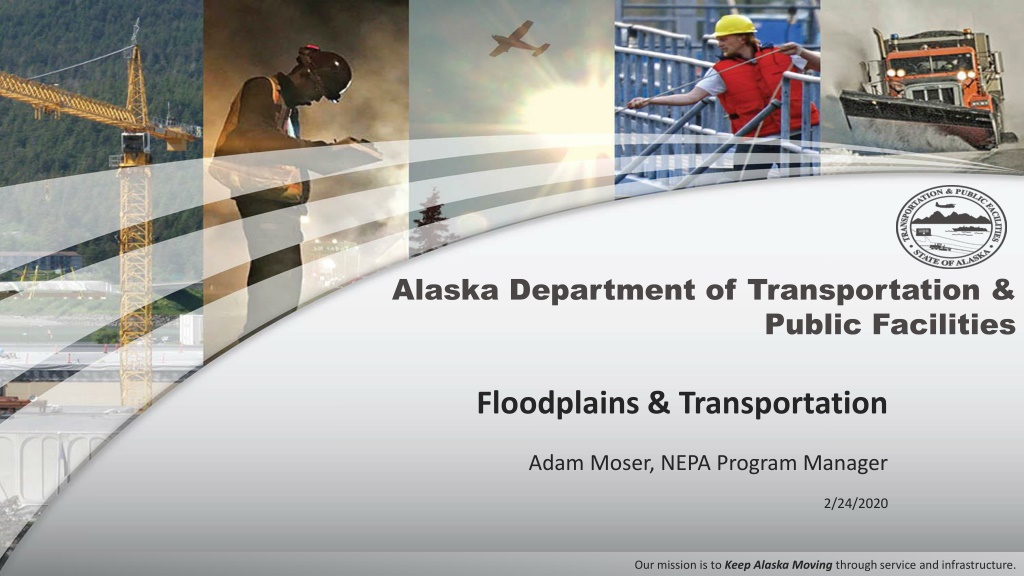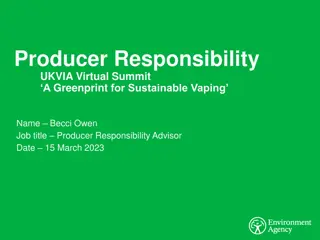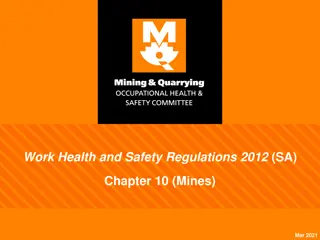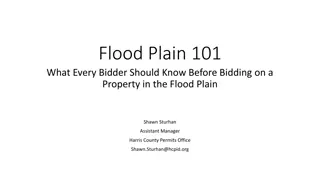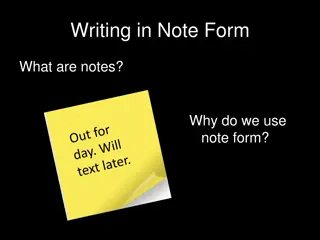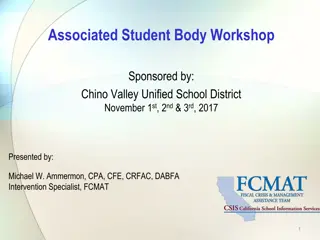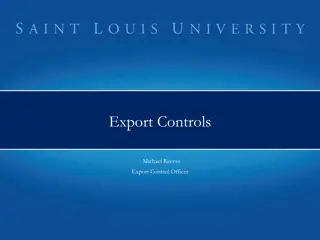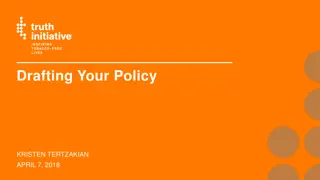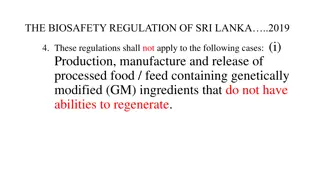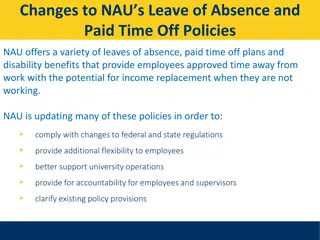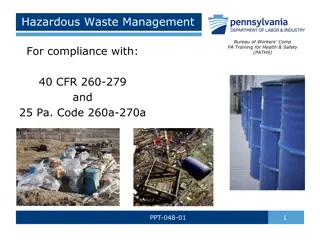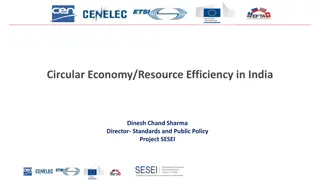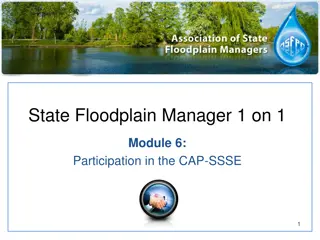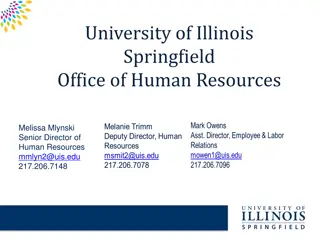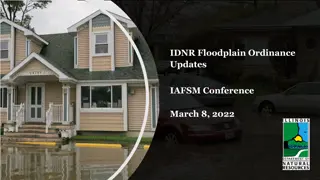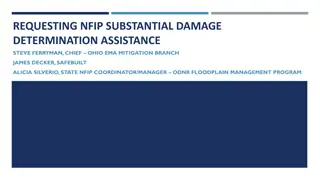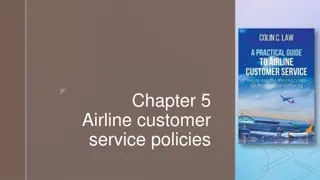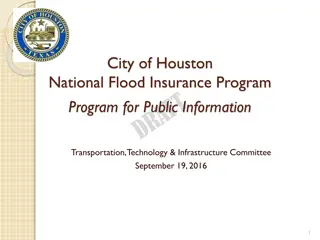Understanding Floodplain Management Policies and Regulations
The provided content highlights key information regarding floodplain management, including the National Flood Insurance Act of 1968 and 1994, Executive Order 11988, 23 USC 650 Subpart A, and updated SEO Floodplain Guidance. These regulations aim to provide flood insurance, establish flood hazard zones, mitigate losses, and regulate infrastructure development in floodplains. The emphasis is on promoting stricter standards to enhance floodplain management and reduce risks associated with flooding events.
- Floodplain management
- Regulations
- National Flood Insurance Act
- Infrastructure development
- Risk mitigation
Download Presentation

Please find below an Image/Link to download the presentation.
The content on the website is provided AS IS for your information and personal use only. It may not be sold, licensed, or shared on other websites without obtaining consent from the author. Download presentation by click this link. If you encounter any issues during the download, it is possible that the publisher has removed the file from their server.
E N D
Presentation Transcript
Alaska Department of Transportation & Public Facilities Floodplains & Transportation Adam Moser, NEPA Program Manager 2/24/2020 Our mission is to Keep Alaska Moving through service and infrastructure.
National Flood Insurance Act of 1968 Primary Goals Provide flood insurance for structures and contents in communities that adopt and enforce an ordinance outlining minimal floodplain management standards (now a National Flood Insurance Program (NFIP) community) Develop maps of flood hazard zones and establish flood insurance rates for structures inside each flood hazard area Improve floodplain management National Flood Insurance Act of 1994 Codified Community Rating System Encouraging communities to create and enforce stricter standards 2
Executive Order 11988 (May 1977) Directed federal agencies to avoid actions located in or adversely affecting floodplains unless there is no practicable alternative; Directed federal agencies to take action to mitigate losses if avoidance is not practicable; Required public notice of floodplain development; and more. 3
23 USC 650 Subpart A (1979) Prescribes Federal Highway Administration (FHWA) policies and procedures for the location and hydraulic design of highway encroachments on flood plains, including direct federal highway projects administered by the FHWA. Definitions: "Action" shall mean any highway construction, reconstruction, rehabilitation, repair, or improvement undertaken with Federal or Federal-aid highway funds or FHWA approval. "Encroachment" shall mean an action within the limits of the base flood plain. 4
Updated SEO Floodplain Guidance DRAFT Clarifies Temporary encroachment An encroachment is temporary if no new permanent infrastructure or features are placed in the floodplain. An encroachment may be temporary, if the action is to return a preexisting feature or structure to an as-built condition and all equipment used in the action can be removed from the floodplain prior to any high-water/flood event. Examples of temporary encroachments include cleaning drainage ditches, drains, or culverts; repaving or restoring existing roadways or bridges to an as-built condition, and so long as all restoration activities facilitate open space use. 5
Updated SEO Floodplain Guidance DRAFT Clarifies Temporary encroachment Any action that adds new drainage structures, changes the size of a culvert, alters the flow of drainage structures, or alters the grade, width, or pavement height of a road does not meet the definition of a temporary encroachment. If there is uncertainty about whether the action qualifies as a temporary encroachment, the action should be treated as an encroachment and the analyst should consult with the hydraulic engineer and obtain an LHS report. 6
Updated SEO Floodplain Guidance DRAFT Temporary Bridges If the project involves a temporary bridge, always consult with your regional hydraulic engineer. If in an NFIP community, consult with the floodplain administrator 7
Updated SEO Floodplain Guidance DRAFT Clarifies Public Notice Requirements for EO 11988 The public notice must identify the proposed action and its potential impacts to a specific waterway, floodplain, or floodway Must provide more information than just stating compliance with EO 11988 8
Public Notice Example 1 Public Notice Example 1 The project is needed because the existing travel surface is inadequate for the intended use. This project will recondition the surface material and clear existing drainage ditches to provide a suitable travel surface and reduce maintenance needs. Access to businesses and residences will be maintained during construction activities. The following Executive Orders (EO) apply. EO 12898, Environmental Justice EO 11593, Protection and Enhancement of the Cultural Environment EO 11988, Floodplain Management EO 13112, as amended by EO 13751, Invasive Species 9
Public Notice Example 2 Public Notice Example 2 DOT&PF is proposing improvements to Glacier Highway as part of the JNU Glacier Highway Improvements (Lemon Creek Area) Project Z-68124-0000. There have been no changes to the project activities as noticed in May 2019. This project encroaches into the base (100 year) floodplain (Flood Maps 02110C1551D and 02110C1532D) and no net changes to the base flood elevation are anticipated. No longitudinal or significant encroachments are anticipated. DOT&PF is soliciting comments and information on the proposed project s floodplain impacts, in accordance with E.O. 11988. 10
Public Notice Requirements for EO 11988 Summary: Must provide more information than just stating compliance with EO 11988 Public notice must identify the proposed action and its potential impacts to a specific waterway, floodplain, or floodway Include intention to comply with EO 11988 Public notice must include members of the general public, government agencies, and any interested parties or stakeholders 11
Updated SEO Floodplain Guidance DRAFT Hydraulic Studies by Consultants DOT&PF Hydraulic Engineers need to review and provide written approval of any hydraulic study used as an LHS Emailed concurrence/approval from DOT&PF hydraulic engineer is sufficient written documentation. 12
Class of Actions & Floodplains 23 USC 771.117(e) constraints for (c)(26), (c)(27), & (c)(28) actions (6) A floodplain encroachment other than functionally dependent uses (e.g., bridges, wetlands) or actions that facilitate open space use (e.g., recreational trails, bicycle and pedestrian paths); or construction activities in, across, or adjacent to a river component designated or proposed for inclusion in the National System of Wild and Scenic Rivers. 13
Programmatic CEs & Floodplains Under the Programmatic CE General Programmatic Approval Condition (n): No actions encroaching on a regulatory floodway or work affecting the base floodplain (100 year flood) elevation of a watercourse or lake 14
Regulatory Floodway A "Regulatory Floodway" means the channel of a river or other watercourse and the adjacent land areas that must be reserved in order to discharge the base flood without cumulatively increasing the water surface elevation more than a designated height. Communities must regulate development in these floodways to ensure that there are no increases in upstream flood elevations. If not in a mapped and NFIP community, there will not be a regulatory floodway 15
Functionally Dependent Uses Functionally dependent use means a use which cannot perform its intended purpose unless it is located or carried out in close proximity to water. (44 CFR 59.1) Bridges and culverts Still need an LHS LHS should state that the encroachment is for a functionally dependent use CE must state that encroachment is for functionally dependent use For (c)(26), (c)(27), & (c)(28) actions: Summarize LHS and explain that the action is for a functionally dependent use on CE form Section II. M. 4. 16
(c)(26), (c)(27), & (c)(28) Actions Location (Encroachment) Analysis Clearly no encroachment = No encroachment Maybe an encroachment in unmapped floodplain = Encroachment Clearly an encroachment = Encroachment Action Analysis Is the encroachment for a functionally dependent use and or temporary? If YES, proceed with (c)(26), (c)(27), or (c)(28) and explain on CE form. If NO, consider (c)(22) or (d)(13). 17
Functionally Dependent Use vs. Temporary Encroachment Action A functionally dependent use >> Requires LHS A temporary encroachment, is not treated as an encroachment, and does not require an LHS On CE Form Section II. M. 4, Explain why the action qualifies as a temporary encroachment 18
M. Floodplain Impacts (23 CFR 650, Subpart A) (mapped or unmapped) YES NO 1. Project encroaches into the base (100 year) flood plain in fresh or marine waters. Identify floodplain map source and date: If yes, attach documentation of public involvement conducted per E.O. 11988 and 23 CFR 650.109. Consult with the regional or Statewide Hydraulics/Hydrology expert and attach the required location hydraulic study developed per 23 CFR 650.111. Answer questions M.1.a through d. If no, skip to M.2. a. Is there a longitudinal encroachment into the 100-year floodplain? b. Is there significant encroachment as defined by 23 CFR 650.105(q)? If yes, attach a copy of FHWA s finding required by 23 CFR 650.115. c. Project encroaches into a regulatory floodway. d. The proposed action would increase the base flood elevation one-foot or greater. 2. Project conforms to local flood hazard requirements. 3. Project is consistent with E.O. 11988 (Floodplain Protection). If no, the project cannot be approved as proposed. 4. Summarize floodplain impacts and mitigation, if any. Include any commitments or mitigative measures in Section V.
M. Floodplain Impacts (23 CFR 650, Subpart A) YES NO 1. Project encroaches into the base (100 year) flood plain in fresh or marine waters. Identify floodplain map source and date: If yes, attach documentation of public involvement conducted per E.O. 11988 and 23 CFR 650.109. Consult with the regional or Statewide Hydraulics/Hydrology expert and attach the required location hydraulic study developed per 23 CFR 650.111. Answer questions M.1.a through d. If no, skip to M.2. a. Is there a longitudinal encroachment into the 100-year floodplain? b. Is there significant encroachment as defined by 23 CFR 650.105(q)? If yes, attach a copy of FHWA s finding required by 23 CFR 650.115. c. Project encroaches into a regulatory floodway. d. The proposed action would increase the base flood elevation one-foot or greater. 2. Project conforms to local flood hazard requirements. 3. Project is consistent with E.O. 11988 (Floodplain Protection). If no, the project cannot be approved as proposed. 4. Summarize floodplain impacts and mitigation, if any. Include any commitments or mitigative measures in Section V.
M. Floodplain Impacts (23 CFR 650, Subpart A) YES NO 1. Project encroaches into the base (100 year) flood plain in fresh or marine waters. Identify floodplain map source and date: If yes, attach documentation of public involvement conducted per E.O. 11988 and 23 CFR 650.109. Consult with the regional or Statewide Hydraulics/Hydrology expert and attach the required location hydraulic study developed per 23 CFR 650.111. Answer questions M.1.a through d. If no, skip to M.2. a. Is there a longitudinal encroachment into the 100-year floodplain? b. Is there significant encroachment as defined by 23 CFR 650.105(q)? If yes, attach a copy of FHWA s finding required by 23 CFR 650.115. c. Project encroaches into a regulatory floodway. d. The proposed action would increase the base flood elevation one-foot or greater. 2. Project conforms to local flood hazard requirements. 3. Project is consistent with E.O. 11988 (Floodplain Protection). If no, the project cannot be approved as proposed. 4. Summarize floodplain impacts and mitigation, if any. Include any commitments or mitigative measures in Section V.
M. Floodplain Impacts (23 CFR 650, Subpart A) (mapped or unmapped) YES NO 1. Project encroaches into the base (100 year) flood plain in fresh or marine waters. Identify floodplain map source and date: If yes, attach documentation of public involvement conducted per E.O. 11988 and 23 CFR 650.109. Consult with the regional or Statewide Hydraulics/Hydrology expert and attach the required location hydraulic study developed per 23 CFR 650.111. Answer questions M.1.a through d. If no, skip to M.2. a. Is there a longitudinal encroachment into the 100-year floodplain? b. Is there significant encroachment as defined by 23 CFR 650.105(q)? If yes, attach a copy of FHWA s finding required by 23 CFR 650.115. c. Project encroaches into a regulatory floodway. d. The proposed action would increase the base flood elevation one-foot or greater. 2. Project conforms to local flood hazard requirements. 3. Project is consistent with E.O. 11988 (Floodplain Protection). If no, the project cannot be approved as proposed. 4. Summarize floodplain impacts and mitigation, if any. Include any commitments or mitigative measures in Section V.
Re-evaluations & Floodplains Always document/correct information on Re-eval forms If not too late, take corrective action 23
Re-evaluations & Floodplains Common Issue: - During Re-eval process it is determined that there is an encroachment that was not documented originally - Get an LHS or have Hydraulic Engineer review Hydraulic Report. - Does the encroachment require a new Class of Action? - Does the encroachment change the programmatic status of the Action? - If yes to either, correct with a new COA or CE. 24
The End Questions & Discussion 25
